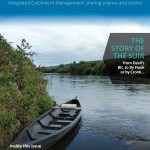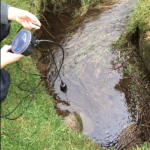The June 2016 issue of the Catchments Newsletter had several…
Catchments, water quality and community science – a tale from County Antrim
Any programme of sustainable development needs to consider not only environmental and economic factors, but also social issues. Case studies, too numerous to mention, show that if the wants and needs of communities are not taken into account, sustainable development projects ultimately fail. Summer 2015 provided researchers from the School of Planning, Architecture and Civil Engineering at Queen’s University Belfast (QUB) with an opportunity to assist members of a local community in southern Co. Antrim in a catchment characterisation programme.
At the same time the programme gave researchers the opportunity to study nutrient transport in a relatively unfamiliar geological setting for Irish Hydrology.
Basalt, although well known to all geologists, is a relatively unusual rock type across most of Ireland. That is except in the northeast where Tertiary basaltic lava flows underlie nearly all of Co. Antrim, along with smaller proportions of the surrounding counties. Although considered an important aquifer in Northern Ireland, looking at hydrographs of rivers draining Antrim’s basaltic catchments would suggest otherwise. Flows typically rise and fall very rapidly following rainfall, in a manner more akin to catchments underlain by poorly productive bedrock (Figure 1). Despite these potentially stressful ecological conditions, many of the catchments in western part of Antrim, draining into Lough Neagh, host unusual aquatic species, including trout subspecies not found elsewhere. At the same time diverse anthropogenic activities, coupled with a flashy hydrological regime make aquatic ecosystems in the area vulnerable to pollution, as reflected by regular fish kills.
Understanding the impact of land use on water quality forms a core element of catchment management. Although higher blanket bog -covered areas of the Antrim Plateau experience limited pollution pressure, human activity proves considerably more intense in lower lying areas (Figure 2). Extensive pasture and associated drainage of wet soils, coupled with widespread intensive livestock rearing units, form a significant suite of potentially polluting agricultural activities, while other pressures on water quality can include (on-site and centralised) sewage disposal, urbanisation, landfills and manufacturing industry.
Concerns about how these diverse activities impact aquatic life in the Sixmilewater River in southwestern Co. Antrim prompted the Sixmilewater River Trust to start a community science initiative to monitor variations in biota throughout the river’s catchment. Following discussion with personnel from QUB, the initiative expanded in summer 2015 to examine influences on river water quality, while at the same time allowing trust members to build up further expertise and understanding of how land use can affect pollutant levels.
Community science initiatives can have a range of benefits, including generating community support for conservation, providing local knowledge to researchers and offering additional human resources to assist in data acquisition. Although this latter point requires an upfront commitment in training and oversight, when completed successfully, it provides a means of collecting more extensive datasets than could be done by researchers alone.
In the case of the Sixmilewater study, Queen’s University Belfast researchers and Sixmilewater River Trust members focused on routine collection of water temperature and specific electrical conductivity (SEC) measurements from across the catchment between June 2015 and August 2015. These measurements permitted comparison of basic water quality parameters with ecological status, and were complemented by continuous temperature/specific electrical conductivity monitoring of stream water quality at four target locations, whose locations were informed by initial catchment-wide specific electrical conductivity surveys. Two supplemental rounds of catchment-wide sampling, completed in July 2015 and August 2015 allowed comparison of field water quality parameters with the results of laboratory-based analyses, the cost of which was covered jointly by the Antrim & District Angling Club and Ballynure Angling Club – both of whom are part of the Sixmilewater River Trust.
Seven rounds of regular Temperature/specific electrical conductivity measurements, made at 38 monitoring points across the 278km2 catchment during the eight week period, revealed specific electrical conductivity to vary from just under 55mS/cm to just over 200mS/cm. Critically, results proved broadly consistent between points during measurement rounds, with those sub catchments that scored highest in terms of ecological health having the lowest specific electrical conductivity. Conversely, sub catchments displaying chronic water quality problems had the highest specific electrical conductivity (Figure 3).
Investigation of results provided by data loggers during July 2015 revealed a gradual increase in specific electrical conductivity, corresponding to a decline in river discharge; this was interspersed with sharp declines (and recoveries) in specific electrical conductivity following periods of intense rainfall. Similar responses were observed in flashy catchments elsewhere during the recently completed EPA-sponsored STRIVE-Pathways research.
Comparison of the results of specific electrical conductivity measurements with those of laboratory analyses revealed an excellent correlation with chloride concentrations (Figure 4), while relationships with nitrate and orthophosphate levels proved less significant.
Overall, mapping the results of the aqueous nutrient analyses across the catchment revealed nitrate levels to be generally low and range between 0.4mg/l-N and 3.0mg/l-N (median 1.76 mg/l-N). By contrast phosphate levels were consistently above the 35mg/l ecological threshold, even in headwaters, where native crayfish occur. Elsewhere lab analyses showed phosphate levels could exceed 10 times the threshold, while concentrations above 190mg/l were noted in samples collected from a semi-urbanised sub catchment displaying consistently poor ecological health.
Chronically high aqueous phosphate levels across the Sixmilewater Catchment point to sustained widespread nutrient sources that impact water quality. This in turn suggests a limited capacity of catchment subsurface materials to attenuate phosphate. In contrast, lower than anticipated nitrate levels suggest reactive processes contribute to denitrification. Examination of TOC analyses from across the catchment, generated by the Geological Service of Northern Ireland (GSNI) Tellus project, shows organic carbon in non-peat soil samples, collected from across the catchment, to typically range between 12% and 25% (Paul Wilson, GSNI personal communication). At the same time although iron levels in soils were also very high, water quality data suggest their role in restricting aqueous P mobility is limited.
Potential aqueous N and P sources across the catchment are manifold. These include on-site wastewater treatment systems. Although Northern Ireland has an extensive rural sewerage network, which discharges to centralised sewage treatment plants, coverage is not comprehensive. Across the Sixmilewater Catchment 3,715 properties were not served by the network and mainly dispose of waste water using smaller on-site wastewater treatment systems. Of these 1,096 are located within 50m of surface drainage. Despite these figures, there appears to be little correlation between higher status streams and on-site wastewater treatment systems occurrence/ density, suggesting that their cumulative impact on catchment water quality is limited.
Overall, study results have demonstrated the benefits that can arise from community science initiatives. Since the completion of this phase of the project, the Sixmilewater Trust is now examining the possibility of longer term water quality monitoring, with a view to better understanding the impact of runoff events on aquatic health, and their association with frequent fish kills across the catchment. At the same time QUB personnel and members of neighbouring trusts are currently investigating the possibility of adopting similar approaches to cross-community science initiatives in North Belfast to rehabilitate industrially contaminated streams. We will be sure to keep readers updated of any future progress on this topic.
Raymond Flynn (School of Planning, Architecture and Civil Engineering, Queen’s University Belfast), Caitlin Buick and Francis Mackin (RPS Consultants, Boucher Road, Belfast)







